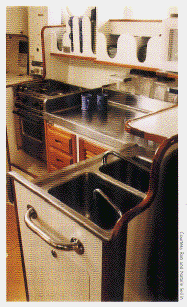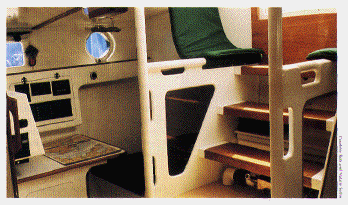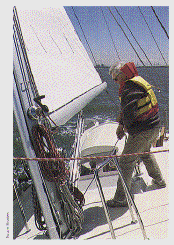

This annual publication will be on newstands through September 2002.

In his "General Remarks on Cruising Life" in part of the wandering narrative, The Long Way, French iconoclastic sailor Bernard Moitessier defended his belief that ocean going boats be built of steel. He wrote, "If a well-plugged bottle is loosed in the middle of a cyclone, it will normally float. For a boat, the main point is the same: if made of metal, well sealed, well designed, breaking seas could roll her over ten times in a row without her sinking." Wilhelm, a brand-new steel cutter designed by the late Joe Hartog and built by Rob Sellin and his wife Natalie West Sellin of Oakland, California, is made of metal, well sealed, well designed and one of the safest boats anywhere.
Like Moitessier's Joshua, Wilhelm is double-ended; more specifically, it has a canoe stern, which means the rudder is inboard, hung below the waterline and is not susceptible to damage from breaking seas. Rob attributes much of the inspiration behind Wilhelm to Moitcssier. "He believed in simplicity and he absolutely believed in the steel double-ender'' Rob said.
Unlike Moitessier, who sailed alone, Rob is devoted to his wife. They built the vessel mostly together - they met when it was still bare frames, back in the mid-80s - and they will sail together, first to Mexico and perhaps around the Pacific in a lazy circle. I had a chance to sail with Rob and Natalie on San Francisco Bay this past spring.
Unlike many couples who sail together, the tasks aboard Wilhelm seemed evenly divided, not based on gender. Natalie, for instance, brought the vessel off the dock and steered as Rob and I hauled up the sails. They appeared equally skilled and interested in running the boat, learning about what it can do in a seaway under various sail configurations. For this day, we had the full rig, main, jib and staysail up.
We tacked our way west across the bay from Oakland, first toward San Francisco and Alcatraz. and then back toward Angel Island, Sausalito and Tiburon. As we approached the Golden Gate, the seas began to build with the ebb until we were climbing up and dropping into steep rollers that were easily 8 feet in height. The vessel progressively came to life in the "worsening" conditions until it was bobbing cheerfully like a duck in the swells and driving well under its three sails. It was surprising, given its heavy construction, how well it sliced to windward in those head seas and it wasn't long before we were even with the headland at Point Bonita. When we spun the boat around and headed for home, the same seas began trying to shove us around at our stern. It was comforting to have them divide without a fuss on the pointy stern and slide harmlessly past. Although the wheel felt a bit heavy in these seas, as though it were too small for the task at hand, the conditions were sloppy and most boats would feel a little squirrelly, particularly if there was a transom for the seas to push against. In general, though, the boat was lively and responsive and, above all, safe and comfortable, attributes it was intended to have from the start.
Rob was initially drawn to Hartog because of the designer's resume: steel commercial fishing boats, like king crab vessels, that were designed and built to handle year-round conditions in the North Pacific. Rob had also heen involved in the fishing industry, first as a fisherman on Block Island Sound, and then as a graduate student at the University of Rhode Island, so he understood what it meant to he at sea when you didn't choose the weather.
Hartog had a book of stock plans, but none was exactly right. But the designer had shown an interest in the enthusiastic, young, would-he boat-builder and wanted to see his project come to life, so he asked what Rob really wanted. Rob explained: a steel vessel with a raised, flush deck; a canoe stern; fine entry; full keel; and short bowsprit. Hartog then designed a boat from scratch and sold the plans to Rob for $600. Hartog's plans included the lines and table of offsets, which were critical to the project, but the interior plan was minimal. "He said, 'We'll worry about it later. You should just get started,"' Rob recalled. That was November 1978.
Rob immediately gathered 2-by-4s from a construction surplus yard, dumped them at a boatyard in San Rafael, Calif., and framed a lofting floor. He spread 15 sheets of plywood aeross his frame and set to work. Unlike many steel builders, he used a plywood platform for laying out and welding his frames, which meant he couldn't tack them down with weld. "'I'he miters had to he absolutely precise," Rob said. "You have to get them exactly right. If the inside or outside of the miters are a little off, you can get suhstantial variations in the shape of the frames that will show in the finished product." Rob chose to soften the lines by making frames for a douhle-chine hull, an allowance Hartog had included in the plans. Frames were 3/16- by 4-inch flatbar and stringers were also 3/16-inch. 'I'he bottom keel plate, stem and keel plate were 5/8-inch and the keel sides were 3/8-inch.
Once the frames were up, Rob installed what he called the "sheer pipe," two 22-foot lengths of black pipe - schedule 80, 1 1/2-inch steel - butt-welded together that became the vessel's sheer, following the fairness of the curve from stem to stern. 'I'he hull plates, 1/8-inch thick above the sheer pipe and 3/16-inch below, were added after this.
Rob then melted his lead - wheel weights and other scrap he had collected - into 200-lb bars. Before placing the final bottom plates, he troweled mastic, a gooey industrial compound, into the keel, which would contain the lead without air holes. He then pressed the lead bars into the mastic. After welding the top plate on, he prcssurized the keel with air to suss out any leaks, which he then sealed. When complete, the 1 2-foot-long keel weighed 10,000 lbs.
Rob put the project aside for a few years in the mid-80s. When he met Natalie, the project was a mass of rusted metal - at least to Natalie's then untrained eye. "I asked Rob when he began thinking of his project as a boat," Natalie said. "And he gave me a blank look, as if l was asking this really silly question, and then he said it was always a boat to him! For me, it didn't become a boat until I saw the hull sandblasted and painted inside and out. Then it began to come to life."
Once the hull was complete urethane foam was sprayed in as
insuiation above the waterline. "We had to be absolutely
sure that we were done cutting metal at this stage," Rob
said. "When this foam burns, the smoke contains cyanide
gas - something you don't want to be around." After the
foam had set, they attacked the foam with bread knives, trimming
it to shape. 'I'hey then applied fire retardant paint over it
and several coats of water-proof epoxy paint over this. Through-out
the construction, Rob said they were hyper scnsitive to safety,
always wearing respirators and eye and ear protection.

The vessel was then ready for an interior. But Hartog had since died, so Rob was on his own. "I figured I'd give it a try," he said. After several false starts, including an attempt to have the interior roughed in angle iron, he looked for professional help. Bill Byrd of Byrd Boats in San Rafael created a basic interior, showed them how to work with West System epoxy, and how to inlay 2-by-4s and support bungs into the 3-inch foam to serve as inter-mediary attachments. Over that was affixed 1/2-inch, medium density, over-lay plywood which had a paper surface good for taking epoxy and finishing. Okume plywood served as ceiling panels and teak battens finished the seams.

The layout of the galley was largely defined
by owner Rob Sellin's purchase of a
scrapped two-hole sink. Stainless counters
were later installed around the salvaged sink.
'l'he galley layout was defined by a two-hole sink Rob had found on a scrap heap. "Rob really had a vision of the galley when he came home with this thing; he was so proud. It sat in the basement for years," Natalie said. But it was eventually refinished and installed in an L-shaped stainless counter and the rest of thc galley designed around it. Natalie built muchl of the interior joinery, learning and cultivating woodworking skills in the same fashion that Rob had learned to be a welder 15 years before.

The vessel's main companionway has two seats on either side
and can be used as an emergency steering station in heavy going.
Like Joshua, which Moitessier fitted with an auxiliary steering system inside the main saloon - a spoked wheel fitted to the saloon's aft bulk-head affixed to a steering shaft -Wilhelm can be steered from down below. Inside the doghouse, where two canvas seats sit on opposite sides of the companionway, a hole in the after bulkhead leads to a shaft that connects to the steering system. In a blow, Rob and Natalie can use their emergency steering system inside the doghouse.

Rob Sellin, seen here tightening the main
halyard, was consistently safety-conscious
during construction; he and Natalie always
wear lifejackets aboard Wilhelm.
Nestled in the forward cabin of Wilhelm is the draining, stainless steel chain locker. It holds 400 feet of chain, one end passed through a hole in the bottom and shackled to a frame and the other to a 75-lb CQR anchor on the bow. 'I'he locker, in its former life, was a beer keg that Rob found, cut the top off with his grinder and bolted into the belly of his boat. He then found a use for the keg's top. Inverted, it serves as the deck iron for the vessel's diesel-drip cabin heater, provided by Sig Marine, which they've since fired up on the cool days typical of the Bay area in winter and spring.
Once the interior was installed, Rob was ready to investigate the possihility of using a steel light pole as the vessel's mast. "I have heard of people using tapered Ameron poles from a company in Oklahoma. You weld all the tangs onto the pole ..." Rob started explaining, but Natalie jumped in, "At a certain point I had to put my foot down. We would still he building the boat if we had done ahsolutely everything ourselvcs." 'l'hey contracted Buzz Ballenger of Ballenger Spars in Watsonville, California. 'I'he resultant 48-foot-tall rig is a true cutter, the mast is positioned nearly half the distance hetween the bow and stern and the headsails are used together, reduced only when the wind starts to build. "Hartog had made the critical call, where to place the compression post, so at least we had a sense of where to start," Rob said.
'I'hroughout construction, Rob consulted with the Milrick brothers, Don and Jeff, in Catati, California, boatbuilders who specialize in metal boat construction and who were kind enough to share their knowledge with an amateur.
Wilhelm is named for Rob's father, a German immigrant who came to the United States in 1928 when he was 19 years old and impressed on Rob the love of working with his hands. Wilhelm Sellin was trained as a cabinetmaker and served his journeyman year by riding around Germany on his bicycle, training with various masters, spending no more than six weeks in one place. Once he arrived in New York, his wandering ways persisted, and he acquired a succession of used Indian motorcycles from the New York State Police, eventually crossing the United States several times before settling in Los Angeles in the late 30s. "I worked with my father in his shop finishing his patterns, which were for the aircraft industry. They were of sugar pine and were for permanent molds to be cast in aluminum and magnesium."
The vessel has been fitted with the latest in electronics, Simrad instruments and Furuno GPS, as well as an IX32-model radar with a custom antenna support from Starrett Marine Stainless of Berkeley, Calif. 'I'he windlass is by Muir; the sails provided by North; winches by Anderson; deck hardware from Harken and Schaefer; VEIF and ~S~SB by Icom; and the liferaft by Switlik. 'I'he exterior and interior LPU finish is Sterling Paint, applied by Andy Richardson of San Rafael. They will receive weatherfax downloads onto their Dell laptop. 'I'he engine is an Isuzu four-cylinder diesel with a 630 series Hurth gear, marinized by Marine Engine and Repair (MER) of Seattle. It sat so long at MER after it was purchased - awaiting completion of the hull - Rob told me, that the personnel expressed regret when it was finally shipped. "They said they got so used to having it around that after it left, they didn't know where to put their coffee cups in the morning."
The electrical system is an unconventional (for the United States) 24 volts, a feature that Rob was introduced to by Dan Hobbel, a friend and fellow boatbuilder with many years of European cruising experience. "Many European boats have 24-volt systems. And I agreed with this efficient principle. My way of thinking was that it was much easier to wire the whole boat in 24 volt.s-and have the major systems like windlass, engine starting and the radar not need extra juice." 'l'he 12-volt systems, like the sailing instruments, VHF and SSB, have their power converted through a DC to DC converter by Vanner. "It's much easier to reduce it than build a whole separate system for the 24-volt eqllipment," Rob added. Electrical monitoring and charging regulation on Wilhelm is by Ample Power in Seattle.
He faced criticism for the 24-volt system over the years, but he has since been vindicated. "Whcn we were at this year's gathering of the Metal Boat ~Society in Vancouver, Wash., the president of Ample Powcr, David Smead, was giving a presentation and he said that 24 volts was the right way to go! And we'd been hearing nothing but the opposite for 20 years," Rob said.
In Junc, thc youngest of the couple's four children graduated from college, lcaaving them frce to cast off. At prcss time, Rol and Natalie were a few weeks away from heading Wilhelm south along the coast of California, with stops planned at Pillar Point, Santa Cruz., Monterey and the Channel Islands. 'l'hey intend to arrive in Mexico for Christmas.
'I'he hailing port on the stern is York, Maine, and the vessel is documented there. Althougll the vessel has never been anywhere close, they have family in Maine and envision that Wilhelm will eventually make its way east. Meanwhile, they just don't know where their travels will lead.
~AYR~